Categories
Types of neck braces

A neck brace, also known as a cervical collar is used to provide stability and support to the cervical spine. They are used to immobilize areas of neck and support your cervical region when there is a condition that needs to be treated. Neck braces offer a non-invasive and safe option to manage or prevent neck pain, treat spinal deformities, muscle weakness, and provide support during the healing process. The common conditions that may require cervical neck collars are extreme sports activities, traumatic neck or head injuries, recovery stage after surgery, therapeutic stage after whiplash injuries, cervical radiculopathy and neck pain.
There are different types of neck braces available in the medical market. They offer varying levels of support and immobilization. Depending upon your requirements, your surgeon will determine the type of brace.
Contents
- Type of neck braces
- Soft cervical braces
- Branfit Cervical Neck Traction Device
- Hard or rigid neck collar
- Truform Rigid Cervical Collar
- Philadelphia neck collars
- TODDOBRA Philadelphia Foam Cervical Collar
- Miami J Cervical collar
- Ossur Miami J Cervical Neck Collar
- Sterno-occipital mandibular immobilization device (SOMI)
- Aspen cervical collar
- Aspen Medical Products Replacement Pads
- Thomas type neck collar
- Freeman Manufacturing Thomas-Type Cervical Collar
- Halo Device or Halo neck collar
- Cervical Thoracic Orthosis neck support (CTO)
- Orthokong Head-Neck-Chest Orthosis Lumbar Support
- Conclusion
Type of neck braces
Soft cervical braces
For patients who require a minimal amount of support for neck and head, soft neck collars are the best choice. They keep the neck and head stable and still to prevent injury. They do not completely immobilize the neck, but they restrict neck and head motion. They provide muscular support during movement. They are used after using the hard cervical collars for a certain period of time for the major healing. So basically, soft ones are used as a transition to wearing no collar.
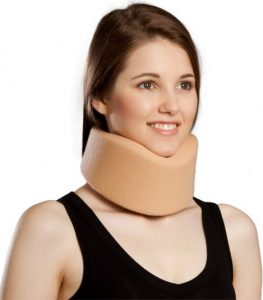
They are comfortable and allow necessary motion required for daily activities. They are mainly used to fix minor cervical issues and after whiplash injury. They are usually helpful for minor neck injuries, and are typically used for few hours a day.
Design – Soft neck collars are made of dense polyurethane foam with a moisture-wicking outer cover. They are cut to mould around the patient’s neck and jaw. This flexible brace is wrapped around the neck with the help of a velcro closure. It can be washed completely, and comes with skin respiration that prevents the risk of itching and irritation of skin.
Indications – The indications for soft neck collars include:
- Minor cervical issues
- Whiplash injury
- Degenerative disc disease
Branfit Cervical Neck Traction Device
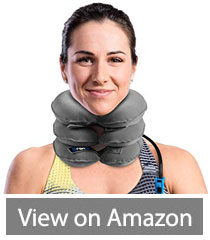 If you have neck pain that doesn’t go away, then this traction device can help. By providing gentle lifting and support for tired muscles, the vertebrae in your neck receive more support and separation.
If you have neck pain that doesn’t go away, then this traction device can help. By providing gentle lifting and support for tired muscles, the vertebrae in your neck receive more support and separation.
This action can result in relief because it takes the pressure off of that area even if you are not sitting with correct posture.
It is designed in the United States, using a comfortable suede design that doesn’t itch at all. Wearing the device is similar to the experience of a wrap-around travel pillow. One size will fit most, with results coming with only 20 minutes of use per day for the first two weeks of using the product.
Pros
- The design includes a large Velcro strap that provides a secure wearing experience.
- You can manually inflate the device so that you’re in control of your comfort levels.
- A spiral metal deflation valve doesn’t wear out as quickly as models using plastic components for this element.
Cons
- Individuals with a collar size of 18 or above may find this device to be too small.
- The plastic components require 24-48 hours of exposure to air to reduce manufacturing odors.
- It can take a lot of time to inflate the product to make it ready for wear.
Hard or rigid neck collar
Made from molded plastic, rigid neck braces provide good support and help in recovering from various kinds of neck pain. It limits the forward and backward movements of neck. They are usually recommended after you have used the halo titanium ring. Rigid neck collar is mainly prescribed to those who have undergone surgery or after severe head or neck injury.
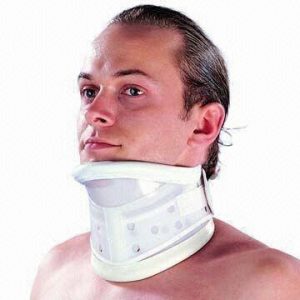
Design– Rigid neck collars come in a variety of sizes to fit the patient’s neck appropriately. The outer layer comprises of a hard thermoplastic support, while the inner layer is made of soft padding. It is important to wear your hard neck collar correctly. It is important that the collar is fitted tight enough to give sufficient support to your neck.
Indications: Some of the conditions for which rigid neck collars can be used are –
- Acute neck pain
- Cervical spondylosis
- Neck strain
- Acute neck injury
- Post surgery
- Spine rehabilitations
- Degenerative neck disease
Truform Rigid Cervical Collar
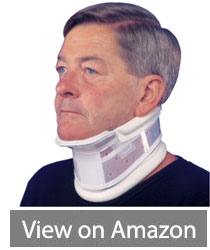 One of the most significant issues that neck braces face is a lack of ventilation. Thick padding can provide users with more comfort. This design also causes the skin to react with a heat rash, acne development, and other uncomfortable issues.
One of the most significant issues that neck braces face is a lack of ventilation. Thick padding can provide users with more comfort. This design also causes the skin to react with a heat rash, acne development, and other uncomfortable issues.
If you have moderate cervical lesions from osteoarthritis or old whiplash injuries, then this stabilizing support can help to provide relief.
It features a hook-and-loop fastening that stays secure during wear. Adjustment panels allow you to get the perfect fit. Then the ventilation points around the sides of the device encourage an increase in your overall comfort.
Pros
- Foam-padded edges make this neck brace suitable for daily wear.
- The contoured chin rest comes equipped with a removable pad for another layer of customization.
- It comes with a secure design so that you don’t need to worry about the latch coming loose with your regular movements.
Cons
- If you have a neck circumference that’s greater than 21.5 inches, then you will be unable to use this device.
- The anterior height only adjusts from 4.5 inches to 6 inches, which may make it unsuitable for some people.
- When the pads begin to wear out, the plastic components can feel like they’re digging into your neck.
Philadelphia neck collars
Philadelphia is a stiff foam collar that has a front and back piece, which are attached on the sides with Velcro. The upper part of this collar supports the lower jaw, while the extension part covers the upper thoracic spine. It is usually used round the clock and should stay on until your doctor tells you remove it. Philadelphia neck collar is mainly used for conditions in which greater restrictions on motion are required. This includes upper spine fractures, cervical fusion surgery, or a cervical strain.
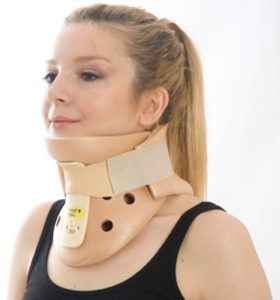
Design – It has a two-piece design, where the front and the back piece are held together by Velcro straps. It is a lightweight, two-piece polyethylene foam material with tough plastic supports at front and rear. While wearing, you need to ensure that the collar is placed in center and the Velcro straps are firmly applied. It offers rigid stabilization with comfort.
Indications – The main indications for Philadelphia neck collars include:
- Cervical fusion surgery
- Significant strain on neck ligaments
- Neck fractures causing instability of cervical spine
TODDOBRA Philadelphia Foam Cervical Collar
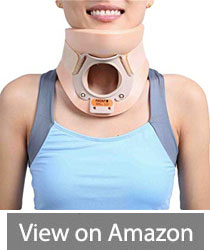 This foam neck traction device provides users with a non-toxic, hypoallergenic wearing experience. It can come into direct contact with your skin without worrying about a reaction, and the unit is free of both CFCs and HCFCs.
This foam neck traction device provides users with a non-toxic, hypoallergenic wearing experience. It can come into direct contact with your skin without worrying about a reaction, and the unit is free of both CFCs and HCFCs.
Because there is no metal included with the design of this device, it tends to have a little extra flexibility compared to other products. The weight your shoulders bear is minimal, so it is suitable for all-day wear.
The design is suitable for MRI or CT scans if ordered by your doctor. It also comes with a well-designed Velcro strap to maintain a secure wearing experience in conditions that reach -30°F. Sizes range from 10-19 inches, so make sure to select the correct size before finalizing any purchase.
Pros
- There are optional cotton liners that you can use with this neck brace (but they are sold separately).
- You can carefully clean the foam after wearing it to preserve its quality.
- Your neck stays in the correct position with this simple design that comes in two separate parts.
Cons
- The trachea opening design alleviates some heat and moisture, but it can reduce the comfort for some users.
- Damage to the foam can compromise the integrity of the entire device.
- The collar is resistant to liquids, but you should not wear it in the shower or submerge it in water.
Miami J Cervical collar
Often known as the advanced form of Philadelphia collar, Miami J is designed for providing extra comfort for the patients with neck injury. The sizing and fitting of Miami J collar is variable to provide the best comfort to the patient. It comes with an additional thoracic extension brace that provides support and protection to the thoracic spine.
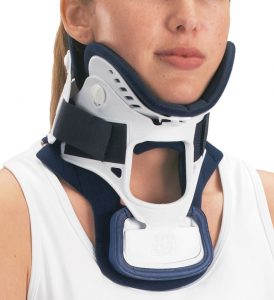
Design – The design of Miami is similar to that of Philadelphia neck collar except the addition of a thoracic extension brace. It comprises of front and back parts that are connected with Velcro straps. The inner side of the braces is covered with protective padding that provides comfort and prevents skin irritation and itching.
Indications – It is indicated in conditions like:
- Cervical fusion surgery
- Neck fractures
Ossur Miami J Cervical Neck Collar
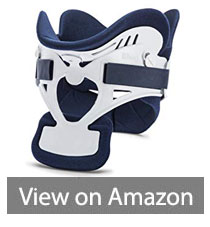 The design of this neck brace promotes healing opportunities for numerous injuries. Herniated discs, sprains, and whiplash all benefit from its use.
The design of this neck brace promotes healing opportunities for numerous injuries. Herniated discs, sprains, and whiplash all benefit from its use.
What sets this neck collar apart from others in this category is the bioengineering included in the design. It actively works to reduce common pressure points that people experience while wearing the device. There is noticeably more comfort around the chin, clavicle, and occiput.
It is easy to put on as well, with only a simple front and back piece to wear that stay together with Velcro straps. If it doesn’t feel comfortable, you can re-do the fitting until you achieve the correct immobilization point.
Pros
- The patented design of this neck brace meets your unique needs by ensuring stability while inhibiting skin breakdown.
- It comes with comfort adjustment buttons for the mandible and occiput.
- You can remove the sternal pad for supine and swallowing if needed.
Cons
- The plastic components of the neck brace can flex at times when the weather turns warm.
- If you have an uncommon neck size, this product may not work for you.
- Heavy use of the product can cause the locking knobs to loosen.
Sterno-occipital mandibular immobilization device (SOMI)
SOMI or Sterno-occipital mandibular immobilization device is a type of rigid neck brace that holds your neck in a straight line with the spine. Basically, it is used to align the cervical region of the neck with the spine to fix the damage done to the neck. It offers a rigid support and prevents a person’s head from moving. Immobilization helps the faster healing of the damaged structures in the neck. While using SOMI neck brace, the patient is not allowed to twist or bend his neck.
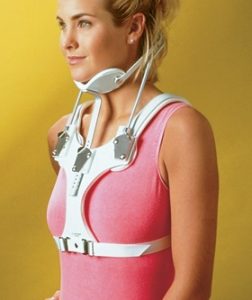
Design – SOMI neck collar consists of several parts that provide support to sternum, jaw and neck. It has a chest plate or sterno at its front, which is connected to the bars going over the shoulder. The chest piece connects to the occipital piece that supports the back of your head. Your lower jaw rests on the chin piece that is connected by straps to a headpiece that is worn across the head. Although complicated to wear as compared to other types of braces, SOMI braces provide excellent support for an injured neck.
Indications – SOMI neck braces are mainly used after cervical spinal surgery or severe neck injury in which head and neck movements could be detrimental. By supporting multiple areas at various levels, they provide excellent support and faster recovery. The drawback of SOMI is that it controls extension less effectively as compared to other braces. Their main indications include:
- Atlantoaxial instability caused by rheumatoid arthritis
- Neural arch fractures of C2, because flexion causes instability
Aspen cervical collar
Aspen neck brace is similar to Philadelphia and Miami-J collar types in most of its design and use. The only difference is in the type of material used for padding. Aspen cervical braces use much more breathable padding material as compared to other two types of cervical collars. It has a hole in the center for the purpose of tracheostomy.
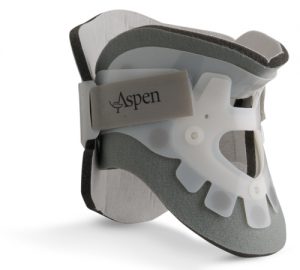
Aspen Medical Products Replacement Pads
 If you own an Aspen neck brace from a previous medical treatment, then the pads from the device will eventually wear out. You can use the dense clickable foam from this authorized replacement to restore the usability of your device.
If you own an Aspen neck brace from a previous medical treatment, then the pads from the device will eventually wear out. You can use the dense clickable foam from this authorized replacement to restore the usability of your device.
These replacement pads are designed to provide cushioning between the skin and the hard shell of the plastic collar.
This product is a one-size-fits-all model. You can take advantage of its hypoallergenic design by giving it a daily cleaning. The foam needs to dry for at least six hours after hand-washing them to receive the best possible result.
Pros
- It will match the look of the pads to your Aspen collar so that your brace continues to be useful in the treatment of your condition.
- The dual-color design makes it easy to know which side is supposed to be facing your skin.
- You can adjust the pads to ensure that no plastic components touch your skin.
Cons
- Because of the stipulation for daily cleaning, you may want to own 2-3 replacement pads.
- This product is compatible only with Aspen collars.
- It is not an exact duplication of the pads that come with the original brace.
Thomas type neck collar
This is a less commonly used type of neck braces. It is made from vinyl plastic and has small holes for ventilation. It’s design is similar to that of soft collar. The only differentiating point is the use of tough material. This provides more rigid support to the neck. It comes with a foam padding on both upper and lower sides of the braces. This helps in preventing pressure sores.
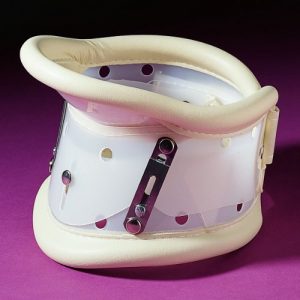
Freeman Manufacturing Thomas-Type Cervical Collar
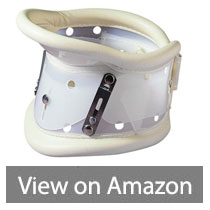 This neck brace provides a higher level of support if your healing requires zero flexibility. It supports those who have cervical disc disease, where the neck begins to feel stiff. You can start to deal with chronic neck pain, inflammation, and muscle spasms that occur when trauma occurs in this area.
This neck brace provides a higher level of support if your healing requires zero flexibility. It supports those who have cervical disc disease, where the neck begins to feel stiff. You can start to deal with chronic neck pain, inflammation, and muscle spasms that occur when trauma occurs in this area.
The Thomas-type design provides a two-piece construction that makes collar adjustments easier than in other full-support models. It comes with a hook-and-pile closure for added stability.
It is much easier to adjust the height of this collar as well because of the overall design. This particular model can provide support at 3.5-4.5 inches to provide healing help for most people. The large size works for people with a neck circumference of 16 inches and up.
Pros
- Several holes along the side of the collar allow for ventilation so that heat doesn’t build up around the neck.
- Instead of plastic bracing adjustments, the manufacturer uses metal components for more stability.
- Comfort padding with high-quality stitching allows you to wear the device all day long.
Cons
- There is minimal padding inside the collar, so it could be uncomfortable for some users when it fits tightly.
- An adjustment period to the device may cause additional discomfort until you get used to the product.
- Individuals with a large neck (greater than 20 inches) may be unable to use this model.
Halo Device or Halo neck collar
Halo neck support, also known as Halo bracing is the most rigid of all the types of braces. It is mainly prescribed to eliminate or restrict movements in the slanting and coronal levels of the cervical spine. It keeps the neck and head in a correct position so as to allow faster healing of the injured spinal column and ligaments. It usually takes twelve weeks to heal the injured or affected areas in the neck.
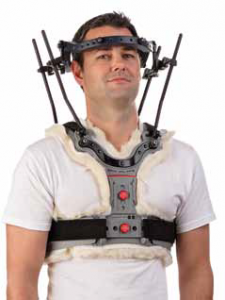
Design – It features a metal ring secured to the head of patient by using metal pins. These four metal pins secure the halo or titanium ring around your head. The ring is then connected to a vest by four bars. This heavy vest is worn on your chest. The goal of vest is to hold the halo and your head steadily in place. It works by exerting a form of spinal traction, where the traction pulls your spinal column in 2 different directions. This in turn creates the tension that reduces the abnormal curvature found in spinal conditions such as Scoliosis. While wearing Halo brace, bending and twisting your body is completely restricted. It is a complex type of brace that is worn and removed only with the help of physician. You can not remove it by your own.
Indications – Halo neck collar is mainly indicated after a complex cervical surgery or unstable cervical fracture. The indications for Halo neck brace include:
- Cervical Spine Trauma
- Hangman’s Fracture
- Severe Instability of the Cervical Spine
- Post Operative Stabilization
Cervical Thoracic Orthosis neck support (CTO)
CTO or Cervical Thoracic Orthosis neck support is used to treat fractures in the cervical spine and the upper back. They provide more support and stability as compared to rigid neck collars. They are designed to provide support and control on different planes, such as rotational, anterior and posterior, and medial and lateral. It not just immobilizes your head, bt also restricts flexion and extension. The aim of CTO neck brace is to keep your neck and head in a neutral position, which in turn promotes healing and prevents further injury. CTO are further available in different styles that serve different purposes. You need to consult your physician to find the right one that meets your needs.
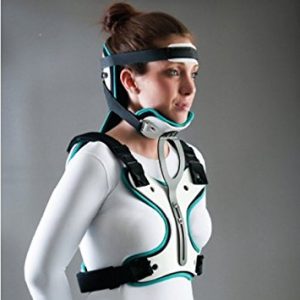
Design – Cervical Thoracic Orthosis comprises of a front piece and a back piece- both of which are connected with straps. The lower rib cage and the back headpiece are connected to the front chin rest with the help of straps. Your doctor will help you wear this neck brace. You will be able to carry out several normal activities by yourself or with little help.
Indications – CTO is indicated in:
- Cervical and Upper Thoracic Spine Trauma
- Degenerative Disc Disease
- Post Operative
- Cervical and Upper Thoracic Spine Instability
Orthokong Head-Neck-Chest Orthosis Lumbar Support
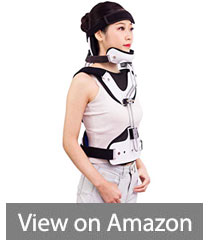 There are times when a doctor may recommend restricting rotation and motion of the head, neck, and chest to promote healing. This completely adjustable brace allows you to use three different configurations to ensure it wears as comfortably as possible.
There are times when a doctor may recommend restricting rotation and motion of the head, neck, and chest to promote healing. This completely adjustable brace allows you to use three different configurations to ensure it wears as comfortably as possible.
Despite its size, this lumbar support is still a two-piece unit that provides foam padding for comfort on all skin contact areas. There are four straps that provide a secure fit, including a helpful headband-style one that supports the top of the head.
You would use this model to treat upper back and neck injuries like spinal stenosis, surgical recovery, and light wedge fractures. Because it limits rotation, there may be limitations to your activities when wearing this device for any reason. It is suitable for men and women.
Pros
- It is possible to lie down and sleep with this brace on thanks to its design.
- The angle-adjustable, breathable, and standard configurations give you a measure of customization.
- You can remove the plush laminated foam for cleaning or comfort as needed.
Cons
- Most people will need help putting the brace on because of how the neck portion of the product sets.
- The four straps can become uncomfortable over time, especially the ones around the waist and the collarbone.
- It is a universal size, so the unit may not work for every person.
Conclusion
Neck braces or neck collars are meant to provide support and stability to the neck, head and back region. It is important to choose the best one for you to avail the maximum benefit of neck collar. Neck collar can be associated with some common problems such as skin irritation and itching, skin sores, problem in swallowing and eating, weakness in neck muscles and troubles with balance. Consult your physician if you experience any of these effects.




